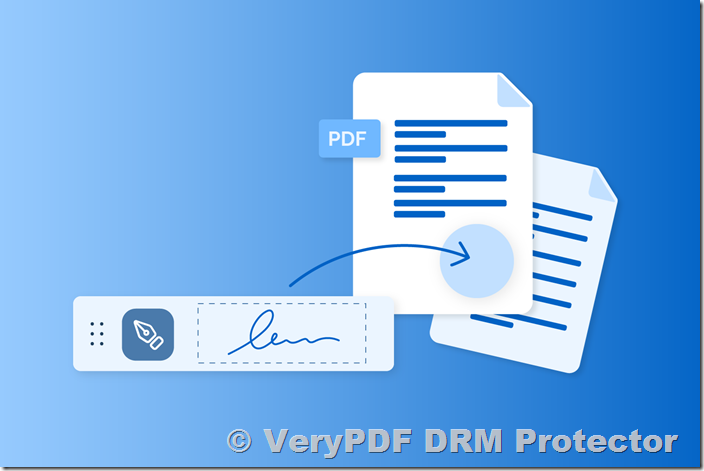Understanding PDF Security: Digital Signatures, Encryption, and DRM
PDF documents are widely used for sharing and distributing information. However, protecting these documents from unauthorized access, modifications, and copying is crucial. Various security measures exist, including digital signatures, encryption, and Digital Rights Management (DRM). But how effective are these methods in ensuring document security?
This article explores the limitations of PDF digital signatures and encryption, highlighting how they can be compromised. It also explains why VeryPDF DRM Protector is a superior alternative for ensuring the highest level of security for your PDF files. You can try VeryPDF DRM Protector for free online at https://drm.verypdf.com/online/.
The Limitations of PDF Digital Signatures
A digital signature is used to verify the authenticity and integrity of a PDF document. While this method helps confirm the document’s source, it does not prevent modifications after signing. Here are some of the primary concerns with digital signatures:
-
External References Can Be Manipulated: A digitally signed PDF may contain links or embedded content from external sources that are not signed. Attackers can manipulate these external elements without breaking the digital signature.
-
OpenAction Vulnerability: PDFs can contain an OpenAction command that automatically runs scripts when the document is opened. This feature can be exploited to introduce unauthorized modifications.
-
Dynamic Content Risks: Some PDFs reference content dynamically, meaning a signed document could still be altered indirectly.
PDF Encryption: A False Sense of Security
Encryption is often used to restrict access to a PDF document, requiring a password to open or modify it. However, this method has its own weaknesses:
-
Partial Encryption Is Risky: Some PDFs use partial encryption, leaving certain elements unprotected. This loophole allows attackers to insert unencrypted malicious content.
-
Weak Passwords and Brute Force Attacks: Many encryption algorithms rely on passwords, which can be cracked using brute force attacks.
-
No Control After Distribution: Once a user decrypts the document, they can save, edit, or share it freely, making encryption ineffective in preventing unauthorized distribution.
Why VeryPDF DRM Protector is the Best Solution
While digital signatures and encryption have their uses, they do not offer complete security. This is where VeryPDF DRM Protector comes in. Unlike traditional security measures, VeryPDF DRM Protector locks PDFs into a proprietary format (vpdf) that can only be opened with VeryPDF’s Secure PDF Viewer.
Key Benefits of VeryPDF DRM Protector:
-
Complete Document Encryption: Unlike standard PDF encryption, VeryPDF DRM Protector ensures that every part of your document is protected.
-
No Unauthorized Modifications: If a protected document is altered in any way, it will fail to open in the secure viewer.
-
Prevents Copying, Printing, and Screenshots: The secure viewer environment blocks unauthorized actions, ensuring document integrity.
-
Access Control and Expiry Settings: Set document expiration dates, control the number of views, and restrict access to specific users.
-
No Passwords Required: Users do not need to remember or enter passwords, reducing security risks.
How to Protect Your PDF with VeryPDF DRM Protector
Securing your PDF documents with VeryPDF DRM Protector is simple:
-
Upload your PDF file to https://drm.verypdf.com/online/ and select ‘Make Secure PDF’.
-
Choose the desired protection settings (disable printing, restrict copying, set expiry dates, etc.).
-
Download the protected file and share it securely.
FAQs
1. What is the difference between PDF encryption and DRM? Encryption protects a document with a password, but once decrypted, it can be freely shared. DRM, on the other hand, ensures that even after opening the document, restrictions (such as copy prevention and access control) remain in place.
2. Can I try VeryPDF DRM Protector for free? Yes! You can try VeryPDF DRM Protector online for free at https://drm.verypdf.com/online/.
3. Does VeryPDF DRM Protector work on mobile devices? Yes, VeryPDF provides secure viewers for multiple platforms, ensuring protected PDFs can be accessed safely on both desktop and mobile devices.
4. How does VeryPDF DRM Protector prevent screenshots? The proprietary viewer can detect screen capture attempts and either block the action or alert the document owner.
5. Can I revoke access to a PDF after sharing it? Yes! With VeryPDF DRM Protector, you can revoke access at any time, even after the recipient has downloaded the document.
6. Is it possible to print a DRM-protected PDF? By default, printing is disabled. However, you can configure the settings to allow or restrict printing as needed.
Conclusion
PDF security is a complex issue, and traditional methods like digital signatures and encryption are not enough to prevent unauthorized access or distribution. VeryPDF DRM Protector provides a comprehensive solution that ensures maximum document protection with complete encryption, access control, and integrity checks.
For the most secure PDF protection available today, try VeryPDF DRM Protector for free online at https://drm.verypdf.com/online/.

